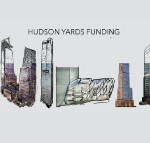Trending
Can Richard Meier’s projects be separated from the man?
New developments may be most vulnerable to association with now-disgraced architect, experts say

When an actor is accused of groping, an audience can boycott his movies. When a politician engages in lewd behavior, he can be voted out of office. A famous architect, however, has his presence stamped all over the skyline, and turning away isn’t so easy.
This week, Richard Meier was the subject of a front-page story in the New York Times in which five women accused the Pritzker Prize-winning architect of a longstanding pattern of sexual harassment. The report prompted an apology from Meier, and he declared he would take a six-month leave of absence from the firm he founded. But for developers and brokers banking on the starchitect’s name to market their projects, the headaches may have just begun.
“It’s a super sensitive issue, and I think that it’s so politically charged right now that if a developer had a project coming out, they would probably try to minimize Meier’s connection to it because it’s raw and new,” said Stephen Kliegerman, who oversees new development marketing at Halstead Property and Brown Harris Stevens.
Meier has at least two major new projects in New York City in the works, Sheldon Solow’s 685 First Avenue — a 596-unit condo tower that topped out late last year — and One Waterline Square, one of three condo towers GID Development is planning on the West Side. At both properties, which are projecting total sellouts of $551 million and $315 million respectively, Meier’s involvement has been a prime branding tool. Solow’s project has been billed as the starchitect’s first black building , a departure from the designer’s addiction to white structures. GID has marketed Waterline Square as the confluence of three powerhouse architects: Meier, Kohn Pedersen Fox and Rafael Viñoly. The project’s website prominently features the faces of founding design partners of each firm. And at 685 First, the first Google hit leads to Meier’s website.
In South Florida, Meier designed the Four Seasons Private Residences at the Surf Club, as well as the hotel.
It is standard practice for luxury developers to highlight the pedigree of the design team behind their projects, particularly when the architect in question is of international renown. Think of how Silverstein Properties capitalized on the Robert A.M. Stern name at 30 Park Place, or the way the Durst Organization did with Bjarke Ingels at Via 57. Having a starchitect’s imprimatur can command premium pricing for a product, if buyers associate it with superior finishes and better long-term value. But, in the words of one luxury developer, “if your whole marketing campaign is built around the starchitect’s reputation, and then that reputation is soiled, you’ve got a problem.”
Live by the sword
Meier was accused in the Times report of behavior that included forcibly trying to kiss one of the women, exposing himself, grabbing an employee’s underwear and asking an assistant to undress. He said in a statement to the newspaper that he was “deeply troubled and embarrassed” by the accounts.
“While our recollections may differ, I sincerely apologize to anyone who was offended by my behavior,” he said.
Compass’ Leonard Steinberg, whose team is handling sales at the Norman Foster-designed 100 East 53rd Street, said of the Meier issue that “I think buildings do have a dilemma because it becomes a big media item.”
“No marketer loves a scandal,” he added.
Alexandra Lange, Curbed’s architecture critic, said she was already “side-eyeing” Waterline Square’s marketing campaign before the allegations against Meier were revealed, “questioning whether highlighting three male architects of a certain age was really the best way to sell condos.”
“I see the recent revelations about Meier as an example of ‘live by the sword, die by the sword,’” Lange said. “If you promote architecture as made by a single creative genius, and use that man in your marketing, if that man behaves badly, it reflects on your property.”
GID declined to comment for this story, as did KPF and Viñoly. Corcoran Sunshine Marketing Group, which is handling sales at Waterline Square, didn’t respond to requests for comment, nor did representatives for Sheldon Solow.
“I don’t envy them,” said one new development marketer who is not working on the project, referring to Corcoran Sunshine. “I’m sure they’re trying to figure out what to do.”
When a new development is first being marketed is when it’s most vulnerable to negative publicity such as the Meier story, said Jonathan Miller, CEO of appraisal firm Miller Samuel. Because that’s when the project’s association with the architect is being heralded to prospective buyers or tenants. Buildings that are already leased up or sold out likely won’t be too impacted by the news, he said.
“It seems unlikely that it would have an impact down the road,” Miller added. “It’s more of a concern upfront during the initial marketing period.”
“If you have Richard Meier design your building, and you’ve invested a lot of money in him and his design is fully baked, you probably try to make the best of the situation,” Kliegerman said. He estimated that starchitect-designed condos command a 10 percent premium. “It’s not just in the premium of the name,” he said. “It’s the quality of design, too.”
The luxury developer, who requested anonymity, said playing down the Meier name might be the prudent thing to do.
“You take his name off the building and you quietly say, ‘Yes, he’s the architect,'” the developer said. “But you don’t scream it from the mountaintops.”
What’s in a name
Miller reckons Meier was the first widely known starchitect in Manhattan, due to the two condo towers he designed at 173–176 Perry Street in the early 2000s. At the time, Meier was riding high from his work on the Getty Center in Los Angeles, and the Perry Street buildings attracted the likes of Martha Stewart, Calvin Klein and techie types from California. He later designed One Grand Army Plaza in Brooklyn.
Both the Perry Street towers and One Grand Army Plaza, however, go by alternate branding names: Meier North Tower and Meier South Tower for the former, and Richard Meier on Prospect for the latter. It’s not clear if any efforts are being made to shed these nicknames. According to StreetEasy, the Perry Street towers and the Prospect Park Property, as well as 165 Charles Street, each have at least one active listing.
“There might be people who think, ‘It’s a Richard Meier building, I’d just as well not live in it,’” said Douglas Elliman’s Roger Erickson.
This was certainly how it played out with some residents at buildings associated with Donald Trump. Various Trump-branded hotels and condos have elected to remove the association with the president’s company from the property.
There’s already been some fallout from the allegations against Meier. Cornell University’s School of Architecture, Art, and Planning said it will decline a recent endowment from him. Sotheby’s has cancelled a solo exhibit of Meier’s work. When reached on Wednesday, representatives for the Getty provided a statement, saying the museum was “deeply dismayed to learn of the serious allegations involving Richard Meier.” A spokesperson said there are “no immediate plans” to change references to Meier, which include a tour of the museum’s architecture and the gift shop. Artnet News reported that the museum cancelled a 20th anniversary dinner that was to be held in Meier’s honor next week.
A spokesperson for the Pritzker Prize, regarded as the most prestigious award for architects, noted that Meier was honored in 1984 based on his “architectural merit at that time.”
“We do not comment on the personal lives of our laureates, but do consider all sexual allegations to be serious, as abusive behavior towards any individual is unacceptable,” she said in a statement.
Steinberg doesn’t believe that Meier’s actions will hurt his projects in the long term.
“Would the behavior of one individual impact the value of a building? I doubt it,” he said. “There have been great geniuses in the past who have produced amazing things that have been monsters. It doesn’t take away from their genius.”
As with other industries, a big question is whether people will be able to separate the architecture from the man, especially given the market’s fixation with celebrity architects. Starchitects often have full teams working with them, but it’s their names that are emblazoned on buildings and marketing materials, and they often share responsibilities with the developer in promoting the product.
Lange said the allegations against Meier will likely serve as a “footnote” to the “tremendous influence” he has had on American architecture. She said that those who write about design will hopefully use this as an opportunity to focus on architects who don’t receive “star treatment” and on the fact that design is product of collaboration rather than one person. Like many industries, architecture is wrestling with gender inequality. Just 10 percent of the highest-ranking jobs at the world’s 100 top architecture firms are held by women, according to a survey by Dezeen. A similar trend is seen at New York City’s largest development and investment firms, with most having leadership teams that are at least 70 percent male, according to an analysis by The Real Deal.
Paul Goldberger, a contributing editor at Vanity Fair and the New Yorker’s former architecture critic, said he hopes that with time, people will be able to disassociate the work from the man and appreciate the “beauty that remains” in his work. By then, he hopes, society will “make clear that certain kinds of behavior cannot be tolerated, and that men in powerful positions will have learned to act differently.”
“If we think of this too much as a matter of big-name architects exerting their power, we risk marginalizing the women who are victims of the less celebrated,” Goldberger said. “If there is any connection to the starchitect, it is that all of this serves as a reminder that creative brilliance and decent and humane behavior do not always go together. But neither are they mutually exclusive.”




